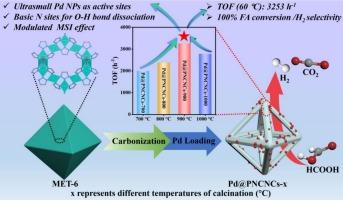在含能金属有机农作met -6衍生的多孔氮掺杂碳纳米笼上固定化Pd纳米颗粒以增强甲酸脱氢
IF 6.9
2区 材料科学
Q2 CHEMISTRY, PHYSICAL
引用次数: 0
摘要
制备具有良好活性和可回收性的非均相甲酸脱氢催化剂,以FA作为有效的氢载体,是一项重要而又具有挑战性的工作。本研究通过对含能金属有机骨架(MOF) MET-6在不同的煅烧温度下进行热解,得到了不同的多孔掺氮碳纳米笼(PNCNCs-x, x代表不同的煅烧温度,单位为℃,本研究的数值可为700、800、900或1000)相应的载体。通过简单的湿法化学还原法制备了锚定在PNCNCs-x载体上的Pd纳米颗粒(NPs),所制备的催化剂Pd@PNCNCs-x可用于FA脱氢制氢。最佳催化剂Pd@PNCNCs-900对FA脱氢表现出优异的催化活性,在60 °C的FA/SF体系(1:2)中,催化剂的初始周转频率(TOF)值为3253 h−1。该催化剂实现了完全的FA转化和100% %的H2选择性,优于其他参考催化剂Pd@PNCNCs-x (x = 700,800和1000)在不同温度的MET热解和大多数mof衍生的碳负载单金属钯催化剂。此外,优化后的催化剂Pd@PNCNCs-900在连续5次反应中保持了良好的可回收性,催化活性略有下降。此外,优化后催化剂Pd@PNCNCs-900的FA脱氢活化能(Ea)可计算为45.97 kJ/mol,低于大多数mof衍生的碳负载单金属Pd体系。Pd@PNCNCs-900具有优异的催化性能,可归因于其高度分散、尺寸超小(2.0 nm)的Pd NPs作为催化活性中心,引入的NPs与PNCNCs-900载体之间的金属-载体相互作用(MSI)效应,以及PNCNCs-900载体中调节的N位点作为促进FA分子O-H键断裂的基础位点。本研究提供了一种以含氮mof衍生的含能碳材料为载体构建高性能钯基FA脱氢催化剂的新方法。本文章由计算机程序翻译,如有差异,请以英文原文为准。

Immobilizing Pd nanoparticles on an energetic metal–organic farmwork MET-6-derived porous nitrogen-doped carbon nanocages for enhanced formic acid dehydrogenation
It is essential yet challenging to assemble the heterogeneous catalysts with satisfactory activity and recyclability for formic acid (HCOOH, FA) dehydrogenation to employ FA as a valid hydrogen (H2) carrier. In this research, through pyrolysis of an energetic metal–organic framework (MOF) MET-6 at different calcination temperature, various porous nitrogen-doped carbon nanocages (PNCNCs-x, x represents different temperatures of calcination with the unit of °C, and the value could be 700, 800, 900 or 1000 in this study) supports were obtained accordingly. Followed by a simple wet chemical reduction method, Pd nanoparticles (NPs) anchored on PNCNCs-x supports were prepared successfully, and the resultant catalysts Pd@PNCNCs-x could be applied in the H2 generation by FA dehydrogenation. The optimal catalyst Pd@PNCNCs-900 demonstrated exceptional catalytic activity over FA dehydrogenation, the catalyst yields an initial turnover frequency (TOF) value TOF of 3253 h−1 in the FA/SF system (1:2) at 60 °C. The catalyst achieves complete FA conversion and 100 % H2 selectivity, outperforming other reference catalysts Pd@PNCNCs-x (x = 700, 800, and 1000) with different temperatures of the pyrolysis of MET and most MOF-derived carbon supported monometallic Pd catalysts. Moreover, optimized catalyst Pd@PNCNCs-900 maintained its excellent recyclability over five consecutive reaction runs, displaying a slight decline in catalytic activity. In addition, the activation energy (Ea) of the optimized catalyst Pd@PNCNCs-900 for the FA dehydrogenation could be calculated at 45.97 kJ/mol, lower than most reported MOF-derived carbon supported monometallic Pd systems. The outstanding catalytic performance of Pd@PNCNCs-900 could be ascribed to the highly dispersed Pd NPs with ultrasmall size (2.0 nm) as the catalytic active centers, the metal-support interaction (MSI) effect between the introduced NPs and PNCNCs-900 support, and the modulated N sites in the PNCNCs-900 support as the basic sites for the promotion of the cleavage of O–H bonds of FA molecules. This study provides a novel approach for constructing high-performance Pd-based catalysts for FA dehydrogenation using N-containing energetic MOF-derived carbon materials as the supports.
求助全文
通过发布文献求助,成功后即可免费获取论文全文。
去求助
来源期刊

Applied Surface Science
工程技术-材料科学:膜
CiteScore
12.50
自引率
7.50%
发文量
3393
审稿时长
67 days
期刊介绍:
Applied Surface Science covers topics contributing to a better understanding of surfaces, interfaces, nanostructures and their applications. The journal is concerned with scientific research on the atomic and molecular level of material properties determined with specific surface analytical techniques and/or computational methods, as well as the processing of such structures.
 求助内容:
求助内容: 应助结果提醒方式:
应助结果提醒方式:


